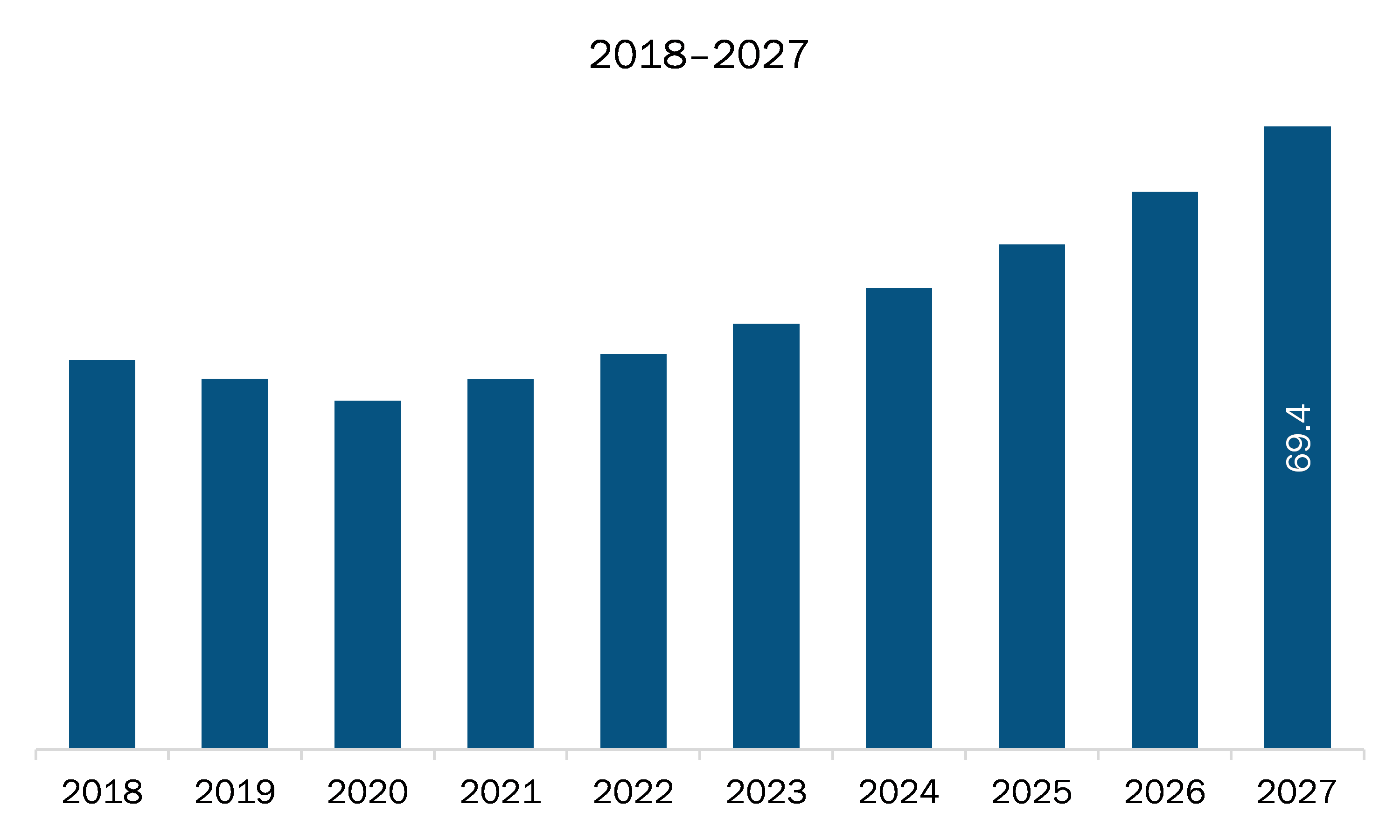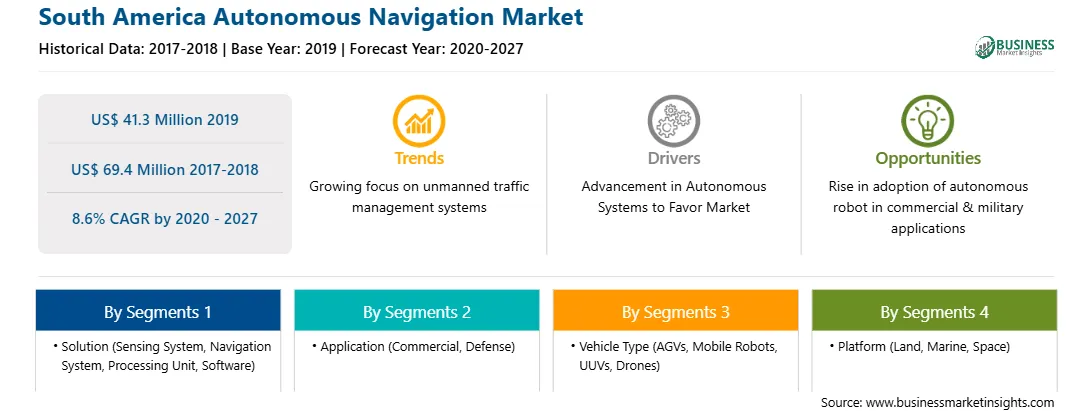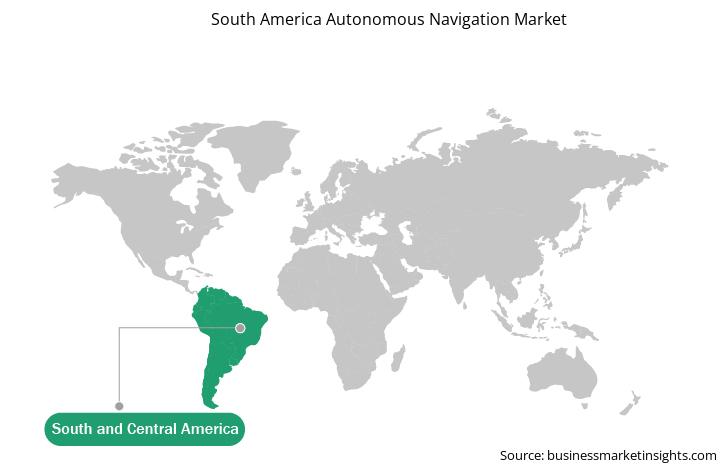The region’s major industries, where the demand for inspection drones, generate enormous opportunities for the autonomous navigation market for its application across mining and agriculture. For mining, the drones can be utilized to help operators perform volumetric measurements. With the help of an autonomous navigation system, the drone platform manages to measure considerable distances compared to terrestrial methods and make quicker calculations of extracted material volume. This makes it efficient for mining, taking photos, monitoring all soil movement, and calculating volumes. According to the study conducted by the Association for the Conservation of the Amazon Basin (ACCA) and the Office of the Special Prosecutor for Environmental Matters (FEMA) of Peru, the application of UAVs is vital to attain insights on numerous criminal activities that compromise the environment and communities in the Amazon basin. Brazilian government uses UAVs for surveillance purposes in areas with high crime rates. Brazil is a leading adopter of military UAVs in SAM for military purposes. Embraer Air Corporation is monitoring the UAV development processes in Brazil. Such initiative is boosting the demand for autonomous navigation in the region. Also, Various AI technologies coming together for growing navigation effectiveness is driving the SAM autonomous navigation market.
SAM is severely affected by the COVID-19 pandemic. In SAM, Brazil reported the highest number of COVID-19 confirmed cases, followed by Ecuador, Peru, Chile, Argentina, and others. Governments in SAM are taking several initiatives, such as lockdowns, trade bans, and travel restrictions, to protect people and control the spread of COVID-19 in the region. These measures are expected to have a direct impact on the region’s economic growth due to lower export revenues from the drop in commodity prices and reduction in export volumes, especially to major trading partners. The sharp decline in the sales of the logistics industry and halt in vehicle production in the region due to lockdown measures is expected to directly impact the growth of the SAM autonomous navigation market.

Strategic insights for the South America Autonomous Navigation provides data-driven analysis of the industry landscape, including current trends, key players, and regional nuances. These insights offer actionable recommendations, enabling readers to differentiate themselves from competitors by identifying untapped segments or developing unique value propositions. Leveraging data analytics, these insights help industry players anticipate the market shifts, whether investors, manufacturers, or other stakeholders. A future-oriented perspective is essential, helping stakeholders anticipate market shifts and position themselves for long-term success in this dynamic region. Ultimately, effective strategic insights empower readers to make informed decisions that drive profitability and achieve their business objectives within the market.

| Report Attribute | Details |
|---|---|
| Market size in 2019 | US$ 41.3 Million |
| Market Size by 2027 | US$ 69.4 Million |
| CAGR (2020 - 2027) | 8.6% |
| Historical Data | 2017-2018 |
| Forecast period | 2020-2027 |
| Segments Covered |
By Solution
|
| Regions and Countries Covered | South and Central America
|
| Market leaders and key company profiles |
|
The geographic scope of the South America Autonomous Navigation refers to the specific areas in which a business operates and competes. Understanding local distinctions, such as diverse consumer preferences (e.g., demand for specific plug types or battery backup durations), varying economic conditions, and regulatory environments, is crucial for tailoring strategies to specific markets. Businesses can expand their reach by identifying underserved areas or adapting their offerings to meet local demands. A clear market focus allows for more effective resource allocation, targeted marketing campaigns, and better positioning against local competitors, ultimately driving growth in those targeted areas.

The autonomous navigation market in SAM is expected to grow from US$ 41.3 million in 2019 to US$ 69.4 million by 2027; it is estimated to grow at a CAGR of 8.6% from 2020 to 2027. With growing industrial economies, the industries are integrating advanced technologies in their business process to optimize productivity. With a growing young and aging working population in industries, the need to incorporate autonomous technologies in the industrial sector is rising, intending to provide products on time. Therefore, industries such as logistics are inclined toward automation to develop automated guided vehicles (AVGs) for time management, accuracy, and productivity. With advancements in robotic technologies, the industrial sector, including logistics, is deploying automation to boost production quality with a better time management aspect.
In terms of solution, the sensing system segment accounted for the largest share of the SAM autonomous navigation market in 2019. In terms of application, the commercial segment held a larger market share of the SAM autonomous navigation market in 2019. Further, AGVs segment held a larger share of the market based on vehicle type in 2019. Also, on the basis of platform, land segment held largest market share in 2019.
A few major primary and secondary sources referred to for preparing this report on the autonomous navigation market in SAM are company websites, annual reports, financial reports, national government documents, and statistical database, among others. Major companies listed in the report are Collins Aerospace, a Raytheon Technologies Corporation Company; FURUNO ELECTRIC CO., LTD.; Kollmorgen; KONGSBERG; Trimble Inc.
Some of the leading companies are:
The South America Autonomous Navigation Market is valued at US$ 41.3 Million in 2019, it is projected to reach US$ 69.4 Million by 2027.
As per our report South America Autonomous Navigation Market, the market size is valued at US$ 41.3 Million in 2019, projecting it to reach US$ 69.4 Million by 2027. This translates to a CAGR of approximately 8.6% during the forecast period.
The South America Autonomous Navigation Market report typically cover these key segments-
The historic period, base year, and forecast period can vary slightly depending on the specific market research report. However, for the South America Autonomous Navigation Market report:
The South America Autonomous Navigation Market is populated by several key players, each contributing to its growth and innovation. Some of the major players include:
The South America Autonomous Navigation Market report is valuable for diverse stakeholders, including:
Essentially, anyone involved in or considering involvement in the South America Autonomous Navigation Market value chain can benefit from the information contained in a comprehensive market report.